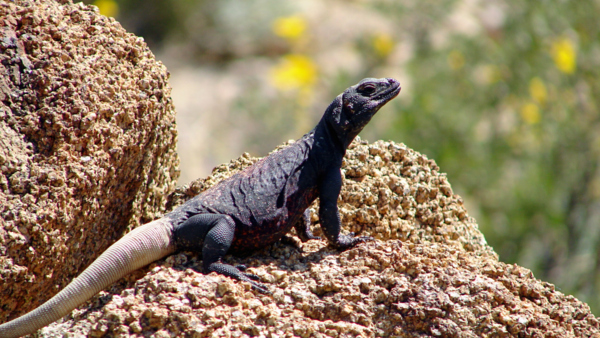What's in a name?
“What's in a name? That which we call a rose, by any other name would smell as sweet” — William Shakespeare
By DR. CAMERON BARROWS
Proper identification and attributing correct names to what we see in nature are keys to natural history, and indeed all science. Prior to 1735, there were no standards or rules for naming species. Every village, every tribe, might call the same species by different names, each believing theirs being the one true and proper name for a species of oak, a bird, or a lizard. Advancing science required that when we talk about a plant or an animal that we all know which one we are talking about. In 1735 Carl Linnaeus, a Swedish polymath, published his first edition of Systema Naturae, the basis for the naming system we use today. Linnaeus’ system proposed the use of binomials, a genus and species, as unique identifiers distinguishing each and every living thing on earth. Each species fit into a hierarchy, beginning at the most general, Kingdom, and then into a cascade toward ever increasing specificity, from Kingdom to Phylum, to Class, to Order, to Family, to Genus, to Species. For instance, for a chuckwalla the classification for naming would be Kingdom – Animalia (all animals), Phylum – Chordata (all animals with backbones), Class – Reptilia (all reptiles), Order – Squamata (all lizards and snakes), Family – Iguanidae (lizards, mostly vegetarians, mostly restricted to the western hemisphere, with specific shaped teeth), Genus – Sauromalus (derived from Greek, meaning “flat lizard”, currently with five known species), and Species – ater (Latin, meaning black), so “flat black lizard.” Fortunately, rather than a literal translation of its binomial, we use the traditional Cahuilla name, chuckwalla.
Given the complexity of life on earth, Linnaeus’ System Naturae was both simple and elegant. However, it was developed both before the internet and before DNA was discovered. Before the internet, the same species might be named, for instance, by a French naturalist and unknowingly by an English naturalist. Rules needed to be established to identify which name had priority. That was easy, the name published first had priority. But, that first publication might be in an obscure local journal, and not “discovered” until years or decades later, while the same species could have been named later, but in a more well-read journal and so naturalists would start using that name.
Back to chuckwallas. Although well known by indigenous, desert-dwelling North American peoples for thousands of years, chuckwallas were first named by a European-based scientist, French zoologist André Marie Constant Duméril in 1856 as Sauromalus ater. Three years later, Scottish zoologist William Baird, unaware of Duméril’s previous name, named chuckwallas Euphryne obesus, (dark, fat lizard). Sixteen years later (1875), American zoologist, Edward Drinker Cope determined that chuckwallas belonged in the previously named genus, Sauromalus.
Curiously and without explanation, Cope retained Baird’s species, obesus, and so chuckwallas were known as Sauromalus obesus (flat fat lizard) for 123 years, until 1998 when Brad Hollingsworth re-discovered Duméril’s priority and much to the dismay of decades of naturalists, he nevertheless correctly re-established chuckwallas as Sauromalus ater. This long and unapologetically arcane path illustrates how names can change over time, and how the self-correcting process can be slow.
Up until the last few decades, the naming of species was done entirely by morphological similarities and differences. It was all about counting scales and teeth, or petals, pistils, sepals, and stamens. Since then, DNA analyses have become the established standard for describing new species. Those new analyses have rearranged family trees, especially for plants and birds. The problem of relying on morphology alone is that unrelated species can converge on each other in appearance if they are responding to similar environmental challenges and opportunities. Likewise, related species might diverge in appearance if their environmental challenges also diverge. DNA reveals relationships, close or far, to or from other known species. However, there is still a reluctance to name new species based on DNA, unless also supported by morphology-based differences. In 2018, Adam Leaché separated three horned lizards, from what was a single species (coast horned lizard) ranging from north-central California (USA) to the tip of Baja California (MX), based on DNA, but that paralleled subtle but consistent morphological differences. Nevertheless, I know a respected though a bit quirky herpetologist, who, last we spoke, stubbornly refused to acknowledge that there is more than a single wide ranging coast horned lizard. There are similar disagreements as to whether the southern sagebrush lizard, Sceloporus vandenburgianus, we see on our higher mountain trails is a subspecies or a distinct full species from the common sagebrush lizard (S. graciosus) of the Great Basin Desert. The DNA supports a full separation, something iNaturalist only recently concurred with.
These species naming conventions, self-corrections, changing names fast or more typically slowly, can be frustrating for naturalists who just want to accurately document what we see and be able to teach others about what species occur where. Then, for some of us, learning new names, and unlearning old ones sometimes seems beyond our capabilities. I am only slightly ashamed of when I feel the need to curse botanical taxonomists who cannot seem to leave the taxonomy I know in place. Still, I get some solace in acknowledging that the use of DNA is still relatively new, and its application means we are getting ever closer to understanding the true kinship relationships among the amazing diversity of species occurring in our region. A focus on analyzing genetic differences between populations can also facilitate an additional scale of conservation efforts. Knowing that and that there is and will be more to learn is a good thing.
Nullius in verba
Go outside, tip your hat to a chuckwalla (and a cactus), think like a mountain, and be safe
